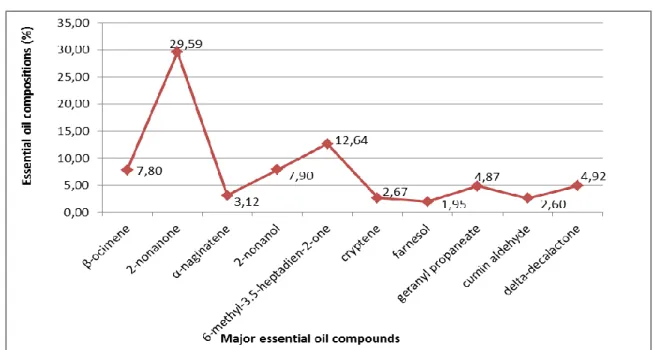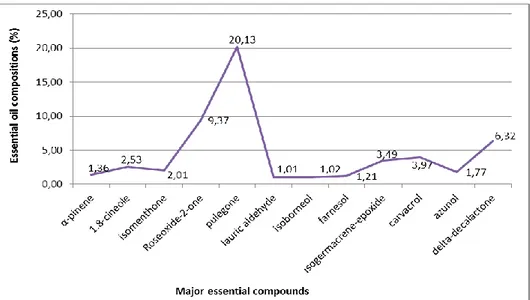www.biodicon.com Biological Diversity and Conservation
ISSN 1308-8084 Online; ISSN 1308-5301 Print
11/1 (2018) 160-165
Research article/Araştırma makalesi
Comparison of essential oil compositions of fresh and dried plant of endemic Salvia cadmica Boiss. var.
bozkiriensis Celep, Kahraman & Doğan, in Turkey
Yavuz BAĞCI
*1, Süleyman DOĞU
2, Sadiye Ayşe ÇELİK
3, Yüksel KAN
31
Selçuk Universty, Faculty of Pharmacy, Department of Basic Pharmaceutical Science Kampus,42250, Konya, Turkey
2Department of Animal and Plant Production, Meram Vocational School, Necmettin Erbakan Univ., Konya, Turkey
3
Selcuk University, Agriculture Faculty, Department of Field Crops, 42049, Konya, Turkey
AbstractIn this study, essential oil compositions of Salvia cadmica Boiss. var. bozkiriensis Celep, Kahraman & Doğan,
(dried and fresh aerial parts) collecting from type locality was investigated. Essential oil was obtained by
hydrodistillation for 3 h using Clevenger type apparatus and the compositions was determined in GC-MS. In this
research, it was observed that the EO compositions varied with respect to be fresh or dry of the plant parts. The LSD
test results revealed that the highest EO content was 2-nonanone (29.59 %) in fresh aerial parts, while the highest
content was pulegone (20.14 %) in dried part of the plant. Furthermore, some EO components were not found in the
fresh aerial parts, while it was determined in dried parts of the plant (p-methylanisole, isomenthone, p-cymene,
homofuranol, azunol, isomenthone, carvacrol, menthylacetate, roseoxide-2-one, pulegone, lauric aldehyde,
isogermacrene-epoxide, isoborneol, geranyl butyrate, valealdehyde and safranol). On the contrary, some components
were observed in the fresh aerial parts, while it was not found in dried parts of the plant (lindoxide, 2-oxapropanoic
acid, α-terpineol, α-terpinene, carvone, geranyl butyrate, valealdehyde and safranol). The objective of the study was that
the determination of the differences between the EO compounds and compositions varied according to be the plant fresh
or dry.
Key words: essential oil, endemic, fresh parts, dried parts, Salvia cadmica var. bozkiriensis
--- ---
Taze ve kurutulmuş Türkiye endemiği Salvia cadmica Boiss var. Bozkiriensis Celep, Kahraman &
Doğan bitkisinin uçucu yağ bileşenlerinin karşılaştırılması
Özet
Bu çalışmada, Doğal lokasyondan toplanan Salvia cadmica Boiss. var. bozkiriensis Celep, Kahraman & Doğan
bitkisinin (yaş ve kuru herbalarında) uçucu yağ bileşenleri araştırılmıştır. Bitkinin uçucu yağı, Clevenger aparatı
kullanılarak 3 saat boyunca hidrotistilasyon yöntemiyle elde edilmiştir ve uçucu yağ bileşenleri de GC-MS ile
belirlenmiştir. Bu araştırmada yaş ve kuru herbadan elde edilen uçucu yağ bileşenlerinin farklılık gösterdiği
gözlemlenmiştir. LSD test sonuçlarına göre, bitkinin taze herbasında en yüksek uçucu yağ bileşeninin 2-nonanon (%
29.59), kurutulmuş herbasında en yüksek uçucu yağ bileşeninin pulegone (% 20.14) olduğu ortaya konulmuştur. Ayrıca
bazı uçucu yağ bileşenleri taze herbada tespit edilmemişken, kuru herbadan elde edilen uçucu yağda belirlenmiştir
(p-methylanisole, isomenthone, p-cymene, homofuranol, azunol, isomenthone, carvacrol, menthylacetate, roseoxide-2-one,
pulegone, lauric aldehyde, isogermacrene-epoxide, isoborneol, geranyl butyrate, valealdehyde and safranol). Bunun
aksine bazı uçucu yağ bileşenleri de taze herbada belirlenmişken, kuru herbada belirlenmemiştir (lindoxide,
2-oxapropanoic acid, α-terpineol, α-terpinene, carvone, geranyl butyrate, valealdehyde and safranol). Çalışmamızın
amacı, bitkinin taze ve kuru herbasından elde edilen uçucu yağ bileşenleri arasında farklılığı ortaya koymaktır.
Anahtar kelimeler: temel yağ, endemic, taze parçalar, kurutulmuş parçalar, Salvia cadmica var. bozkiriensis
*Corresponding author / Haberleşmeden sorumlu yazar: Tel.: +903322231889; Fax.: +903322410106; E-mail: ybagci66@gmail.com
1. Introduction
Salvia L. (tribe Mentheae: subtribe Salviinae), the largest genus of the family Lamiaceae, representing a
diverse cosmopolitan assemblage of nearly 1000 species. The genus is found predominantly in 3 regions of the world;
there are at least 500 species in Central and South America, 200 species in western Asia, and 100 species in eastern
Asia (İpek et al., 2012; Ranjbar and Paketchi 2014; Walker et al., 2004).
The genus Salvia, with about 700 species and represented in Turkish flora by 88 species and 45 endemics, is
one of the most widespread members of the family Lamiaceae. An unusually large number of useful secondary
metabolites belonging to various chemical groups, such as essential oils, terpenoid compounds, and phenolic
derivatives, have been isolated from the genus, which features prominently in the pharmacopoeias of many countries
throughout the world (Bondhorpe et al., 1989; Luis et al., 1992; Ulubelen and Topcu 1992).
Salvia cadmica Boiss. var. bozkiriensis is an aromatic herb belonging to Lamiaceae. The wild growing species
is endemic to on calcareous rocks of Turkey, widely distributed from 1000 to 2000 m (Celep et al., 2011).
The genus Salvia is known throught the world as important because of the useful essential oils produced by the
foliage. Many species and varieties grown wild or are cultivated in many parts of the world. The herbs and their
derivatives such as essential oils are used commonly in the food, drug and perfumery industries. These oils are used as
flavorings, fragrances in the food industry, and for medicinal purposes in several regions. Infusion of dried leaves of
some Salvia genus are used for their spasmolytic, hypoglycaemic, diuretic, choleretic and emmenagogue properties in
flok medicine (Kelen and Tepe 2008). Perhaps the best known and widely used sage oils come from Dalmatian sage (S.
officinalis) and from clary sage (S. sclarea) (Ford et al., 2011; Kamatou et al., 2008). Also, Başer et al. (2009) were
studied Comparative Morphological and Phytochemical Characterization of Salvia cadmica and S. smyrnaea).
S. cadmica var. bozkiriensis belong to the family Labiatae is perennial herbaceous plants collected from type
locality (Bozkır-Konya) Turkey.
The aim of this study was to establish the chemical composition of dried and fresh aerial parts the S. cadmica
var. bozkiriensis growing wild in Turkey. In the present paper, we report for the first time on the chemical composition
of the essential oils obtained from aerial parts of dried and fresh S. cadmica var. bozkiriensis.
2. Materials and methods
2.1. Plant materials
Fresh aerial parts of S. cadmica var. bozkiriensis was collected during the flowering period from Bozkır Konya
in 2011 and the aerial parts were dried in the shade at room temperature. Plant was identified by Dr. Bağcı, and a
voucher specimen (Doğu 3421 & Bağcı) is kept at the herbarium of the Biology Department, University of Selçuk,
Turkey.
2.2. GC-MS profile of the plant parts
Aerial parts (dried and fresh branch, leaf and herb) of the S. cadmica Boiss. var. bozkiriensis were subjected to
hydrodistillation for 3 h using Clevenger type apparatus to produce essential oil. The essential oils were stored at -200C
until analyzed.
GC analysis was performed on a Agilent 6890N Network GC system combined with Agilent 5975C VL MSD
Network Mass Selective Detector. The GC conditions were; column, DB Waxter- HP Innowax Capillary (60.0 m × 0.25
mm, 0.25 μm); oven temperature programme: The column held initially at 60
oC for 10 min after injection, then
increased to 220
oC with 4
oC/min heating ramp for 10 min and increased to 240oC with 10
oC/min heating ramp without
hold; injector temperature 250oC; carrier gas; Helium; inlet pressure, 9.60 psi; linear gas velocity, 7 cm/sec; initial flow
0.3 ml/min; split ratio, 65.0:1; injected volume 1.0µl. MS conditions were regulated as follows; ionization energy: 70
eV, ion source temperature: 280 °C; interface temperature: 250 °C; mass range: 35–450 amu.
Determination of the components was performed by comparison of their mass spectra with Wiley 7.1 and Nist
GC–MS Libraries and retention indices, relative to n-alkanes, with corresponding data from relevant literature. The
percentages of the components were calculated from the GC peak areas using the normalization method.
3. Results
3.1. Essential oil composition of Salvia cadmica Boiss. var. bozkiriensis Celep, Kahraman & Doğan
Results was indicated that there were significant (p<0.01) differences between the the aerial parts of dried and
fresh S. cadmica var. bozkiriensis with respect to their essential oil compositions. The oil yields of the the plants was
determined to be in amount trace. The LSD test results revealed that the highest EO content was 2-nonanone (29.59 %),
(4.92 %) in fresh aerial part of the plant. EO composition may vary considerably between aromatic plant species and
varieties, and within the same variety from different geographic areas (Zygadlo and Julianı 2003). On the other hand, in
this research, it was found that the EO compositions varied with respect to be fresh or dry of the plant parts. According
to this data, on the contrary, it was observed that the highest EO content was pulegone (20.14 %), followed by
roseoxide-2-one (9.37%), delta-decalactone (6.32 %), carvacrol (3.97 %) and isogermacrene-epoxide (3.49 %) in the
dried aerial part of the plant. The major EO compositions was also shown in Figures 1, 2 and 3.
Figure 1. Essential oil compouds and compositions of the aerial dried and fresh parts of Salvia cadmica Boiss. var.
bozkiriensis
Figure 2. Major essential oil compounds and compositions of the aerial fresh part of Salvia cadmica Boiss. var.
Bozkiriensis
It was also presented in Table 1 that, some EO components were not found in the fresh aerial parts, while it
was determined in dried parts of the plant (for instance; p-methylanisole, isomenthone, p-cymene, homofuranol, azunol,
isomenthone, carvacrol, menthylacetate, roseoxide-2-one, pulegone, lauric aldehyde, isogermacrene-epoxide,
isoborneol, geranyl butyrate, valealdehyde and safranol).
Figure 3. Major essential oil compounds and compositions of the aerial dried part of S. cadmica Boiss. var. bozkiriensis
Table 1. The essential oil compositions of the fresh and dried aerial parts of Salvia cadmica Boiss. var. bozkiriensis
RI Compounds Fresh (%) Dried (%)
1021 α-pinene 0.69 1.36 1110 sabinene 0.44 0.48 1196 limonene 0.52 0.88 1200 cis-4-decenal 0.37 0.00 1202 1.8-cineole 0.84 2.53 1224 p-methylanisole 0.00 0.34 1226 β-ocimene 7.81 0.00 1236 p-cymene 0.00 0.77 1292 2-nonanone 29.59 0.90 1298 α-naginatene 3.13 0.00 1438 lindoxide 0.24 0.00 1493 isomenthone 0.00 2.01 1516 2-nonanol 7.90 0.00 1522 camphor 1.59 0.00 1539 linalool 1.75 0.00 1561 methyl acetate 0.00 0.28 1583 6-methyl-3,5-heptadien-2-one 12.64 0.78 1605 Roseoxide-2-one 0.00 9.37 1657 pulegone 0.00 20.13 1680 lauric aldehyde 0.00 1.01 1685 cryptene 2.67 0.00 1686 isoborneol 0.00 1.02 1688 farnesol 1.95 1.21 1700 α-terpineol 0.35 0.00 1703 α-terpinene 0.51 0.00 1749 carvone 0.50 0.00 1758 geranyl propaneate 4.87 0.00 1759 geranyl butyrate 0.00 0.86 1799 cumin aldehyde 2.60 0.50 1814 valeraldehyde 0.00 0.47 1942 safranol 0.00 0.96 2101 isogermacrene-epoxide 0.00 3.49 2128 2-oxapropanoic acid 0.03 0.00 2217 carvacrol 0.00 3.97 2245 azunol 0.00 1.77 2283 homofuronol 0.00 0.66 2351 delta-decalactone 4.92 6.32

